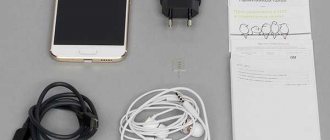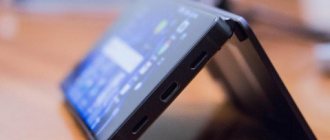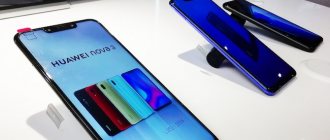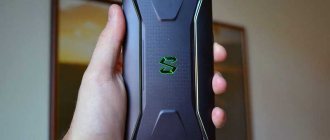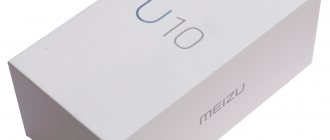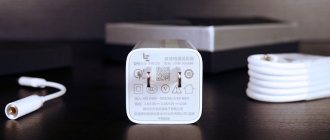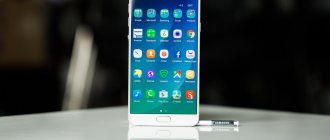This fall, the Chinese company LeEco literally burst into the Russian market, starting an offensive with a powerful PR campaign: low prices for high technologies and unprecedented discounts, right away - its flagship store in Moscow and ambitious plans to become a kind of “Oriental Apple”. The main event, of course, was the amazingly affordable and powerful smartphones. Can a top-end gadget cost 2 times less than competitors with similar parameters? Let's see how the much-hyped Le Max2 .
The best Telegram channel about technology (possibly)
Specifications (Le X820)
- Processor: Qualcomm Snapdragon 820 MSM8996, 2.15 GHz (4 cores)
- Video processor: Adreno 530
- Operating system: Android 6.0.1 Marshmallow + EUI (5.8.016S)
- Display: 5.7″, Super IPS, 2560 x 1440 pixels, 450 nits, capacitive multi-touch
- RAM: 6 GB
- Internal memory: 64 GB
- Sim: 2 nano-sim cards
- Main camera: 21 MP (LED flash, autofocus, optical stabilization, F/2)
- Front camera: 8 MP
- Audio: MP3, AAC, WAV, supports Dolby Atmos technology, compatible with 24-bit/192 kHz audio format, has an active noise reduction system
- Connectivity: GSM 900/1800/1900, 3G, 4G LTE, LTE-A, Wi-Fi 802.11 (a/b/g/n/ac), Wi-Fi Hotspot, Wi-Fi Direct, Wi-Fi Display, Bluetooth 4.2
- Navigation: GPS, A-GPS, GLONASS, BeiDou
- Battery: 3100 mAh (lithium polymer, non-removable)
- Ports: USB Type-C
- Sensors: light, proximity, Hall, gyroscope, compass, fingerprint reading
- Other functions: Hands-free calling (built-in speaker), Voice dialing, Voice control, Airplane mode, Flashlight
- Dimensions: 156.18 x 77.6 x 7.99 mm
- Weight: 185 g
- Case materials: metal and plastic
- Color: gray, gold
- Cost at the time of testing: from 27,990 ₽
About the LeEco Le Max 2 smartphone: “complete stuffing” for $250
LeEco (formerly LeTV) is a company that almost no one outside of China knew about last year. Previously, LeEco’s main activity and source of income was Internet television, a kind of Chinese analogue of the well-known Netflix and YouTube. But in 2015, 5 years after successfully going public and with a solid user base behind it, the company introduced its first line of Le smartphones (1, 1 Pro and Max). Due to an adequate price tag and good technical characteristics, smartphones have found popularity not only in China, but also among enthusiasts abroad. A year later, LeEco announced the second generation of Le smartphones (2, 2 Pro and Max 2) with an equally attractive price-performance ratio. In this article I will talk about my short experience of using the top model from the new line.
The text may and most likely does contain grammatical, spelling, punctuation and other types of errors, including semantic ones. I strongly encourage readers to point out these errors and correct me through private messages.
Content
- Specifications
- Contents of delivery
- Appearance
- Operating system and shell
- Hardware platform
- Calls, multimedia, GPS
- Autonomy
- Cameras
- Results
- Where can I buy?
Specifications
| Screen: | 5.7-inch IPS display with QHD (2560 x 1440) resolution and oleophobic coating |
| Case materials: | metal back with plastic inserts on top and bottom |
| Colors: | rose gold (pink), gold (gold), gray (gray) |
| CPU: | quad-core Qualcomm Snapdragon 820 (64 bit, Kryo architecture, 14 nm process technology); two cores operate at up to 1.6 GHz, and the other two can be overclocked to 2.15 GHz |
| Graphic arts: | Adreno 530 (624 MHz) |
| Operating system: | EUI 5.6 based on Android 6.0 |
| RAM: | 4/6 GB (LPDDR4, 1866 MHz) |
| User memory: | 32/64/128 GB (UFS 2.0) |
| Camera: | 21 MP (f/2.0 aperture), Sony IMX230 sensor (1/2.4″), phase detection autofocus, optical stabilization, LED flash, 4K video recording; front camera 8 MP, f/2.2 aperture, 85° viewing angle |
| Network support: | GSM/EDGE (850/900/1800/1900MHz), CDMA 1X/CDMA2000: BC0/BC1, WCDMA (850/900/1900/2100MHz), TD-SCDMA, FDD-LTE (Band 1/2/3/4/ 5/7/8/12/17/20/25/26), TDD-LTE (Band 38/39/40/41), two slots for nanoSIM cards, one radio module |
| Wireless technologies: | Wi-Fi 802.11 a/b/g/n/ac (MU-MIMO, 2.4 and 5 GHz), Bluetooth 4.2 (LE), GPS/GLONASS/BDS, A-GPS support |
| Sensors: | Fingerprint scanner, accelerometer, gravity sensor, Hall sensor, gyroscope, digital compass, distance and light |
| Additionally: | USB 2.0 Type-C port with USB-OTG support, fast charging using Le SuperCharge technology (QC 3.0), IR port, LED indicator, no standard 3.5 mm headset jack |
| Battery: | 3100 mAh, non-removable |
| Contents of delivery: | power supply (3.6-8 V 3 A, 12 V 2 A), USB cable, USB Type-C -> 3.5 mm adapter, silicone case, paper clip for removing the tray, instructions |
| Dimensions: | 156.8 x 77.6 x 7.99 mm |
| Weight: | 185 grams |
| Cost (official) | from 2099 yuan |
| Cost (real): | from $250 (depending on the site) |
The current line of LeEco smartphones includes 3 models: Le 2, Le 2 Pro and Le Max 2. The most popular variation of the latter among 4PDA users at the moment is the pink version with 4 GB of RAM and 32 GB of user memory. The gray version has not been on sale for a long time and has only begun to appear now, although the price tag still leaves much to be desired.
Contents of delivery
Everything, in principle, is standard: a smartphone, a power supply, a USB cable, a paper clip, pieces of paper and... a puny USB Type-C adapter -> 3.5 mm audio output. Those. Not only did they remove the connector itself, but they also put the adapter on a “string” instead of a good wire. In general, this idea of cutting out the audio output makes me a little “bombed,” so be prepared for similar outbursts later in the text.
I doubt that with active use the adapter will last at least several months, so I definitely advise you to stock up on adapters from Aliexpress for 1.5-2 bucks apiece.
Appearance, ergonomics and display
The design of the smartphone is clearly not for everyone, especially in pink. At the same time, the most criticism is caused by the front panel with impressive black frames and painted metal chamfers on the sides of the display.
The chamfers, moreover, are not removed evenly. Apparently this is some kind of new trend in smartphone design. The glass covering the display protrudes beyond the body, so placing the smartphone with the display down is not recommended.
This is where the complaints about the design of the smartphone practically end and all that remains is to note the main camera protruding beyond the body. Fortunately, here the glass was still recessed relative to the rim.
The fingerprint scanner is located in a sufficient recess just below the main camera lens. It works unstable, the accuracy and speed of unlocking are poor. In the same budget phones from Xiaomi, the fingerprint sensor copes with its task much better. The method of entering one fingerprint into several memory cells does not change the situation.
Let's return to the front panel. At its bottom there are 3 touch keys, which can only be detected if the backlight is active or if you look very closely. At the top everything is standard: an indicator LED, a camera, sensors and a speaker.
Le Max 2 has a display with QHD resolution, i.e. 2560 x 1440 pixels. The only explanation for such a move is the use of a smartphone as part of virtual reality helmets, which are now being talked about on every Internet corner. In everyday use, QHD resolution only gets in the way, because The performance and autonomy of the device decreases.
The viewing angles of the display are maximum, the brightness is adjustable from 5 to 486 cd/m2. In the sun, information from the screen can be read without problems. The origin of the protective glass is unknown, but the quality of the oleophobic coating is worthy of praise.
There is only one speaker at the bottom end, and a microphone is hidden behind the adjacent grille. The location of the multimedia speaker is no less subjective than the diagonal of the display. For example, I would prefer a rear speaker, like the Xiaomi Redmi, or a front speaker, like the Huawei Nexus 6P, to an end-mounted arrangement.
It’s difficult to say anything about the ease of using Le Max 2 with one hand after using the 6.44-inch Xiaomi Mi Max, the size of which I’m used to. Yes, I am a somewhat strange person, no doubt. For the last couple of years I’ve been into compact smartphones, but now I’m used to 6.44″. Le Max 2 lies quite comfortably in the hand due to its beveled and sharpened edges. As convenient as it gets for a 5.7-inch phablet. It still tends to slip out of your hands, just like all other devices with a display diagonal of 5 inches or more.
The build quality of the device is not satisfactory, but the design features I mentioned above should be taken into account when considering a smartphone for purchase. I can characterize the design as “cool,” but most users will still hide their smartphone in a case, right?
Operating system and shell
LeEco is one of many companies that do not hesitate to exploit Apple’s developments, and sometimes even directly copy them. It’s not that I blame companies for this, it’s just that sometimes they can’t even copy qualitatively. To compare the appearance, we’ll make do with the “Clock” application (Le Max on the left), because in most other standard programs the situation is similar.
The operating system is EUI based on Android 6.0.1 Marshmallow. It should be noted that only Chinese and English system languages are available in the official firmware, and there are no Google Play services. I received a smartphone from Gearbest with custom firmware from Cuoco92. Russian and Ukrainian localizations are present in this firmware, but their quality leaves much to be desired: the fonts do not “fit” into the design, some menu items are not translated, and there is no Cyrillic alphabet for quickly searching for contacts in the dialer. There were no problems with the Play Market. OTA updates are not available, so you will have to install software updates manually.
EUI does not have a standard list of installed programs, and all applications immediately go to the desktop. The curtain serves only to display notifications, while the controls have moved to the multitasking center, which is called up by pressing the Menu touch key (on the left). You cannot expand the curtain in full-screen applications, so you won’t be able to quickly see the time, remaining battery charge, or missed notifications without leaving WoT: Blitz.
There is hope that with the release of LeEco on the Russian market, normal localized firmware will appear, but for now we will have to be content with the works of w3bsit3-dns.com users. Despite the incidents with localization and the widespread inheritance of iOS, the system and third-party applications work quickly and quite stably, and no freezes were observed during the entire period of operation.
Hardware platform
Snapdragon 820 is the top and most powerful mobile chipset of 2020. The SoC has 4 powerful Kryo architecture cores: two operate at frequencies up to 1.6 GHz, and two more are overclocked up to 2.15 GHz. The Adreno 530 graphics accelerator operates at frequencies up to 624 MHz. The synthetic performance of the latter is about 500 GFLOPS, which corresponds to a full-fledged desktop card from 5 years ago with a thermal package of 100 W.
True, there are still no normal games for mobile platforms. Even the most demanding World of Tanks: Blitz loads this GPU by no more than 70-80 percent. FPS at maximum graphics settings does not fall below 55 units. Gameplay video on the FERUMM.COM channel.
Performance test results in comparison with other popular devices:
| Phone/Benchmark | 3DMark IS Unlimited | GFXBench 1080p Manhattan Offscreen (fps) | Geekbench 3 (Single/Multi) | AnTuTu Benchmark |
| Xiaomi Mi Max (Snapdragon 650) | 17902 | 8,8 | 1544 / 3680 | 77959 |
| Meizu M1 Metal (Helio X10 MT6795) | 14801 | 4 | 890 / 4836 | 55209 |
| ZUK Z1 (Snapdragon 801) | 19594 | 12 | 991 / 2990 | 47075 |
| Xiaomi Mi4c (Snapdragon 808) | 19564 | 9,9 | 1241 / 3222 | 50610 |
| Xiaomi Mi 5 (Snapdragon 820) | 29891 | 30 | 2319 / 5507 | 131142 |
| LeEco Le Max 2 (Snapdragon 820) | 31160 | 26 | 2094 / 4996 | 130232 |
As the load increases and the SoC heats up, throttling appears, but the power reserve is such that the drop in performance is simply not noticeable even in resource-intensive applications. On the back side, the smartphone heats up to 45° C when powered by a battery and up to 50 degrees when powered by an AC adapter.
The maximum performance drop was 15%
Another advantage of the flagship chip in a smartphone is the operation of the disk subsystem according to the UFS 2.0 standard. Read/write memory performance in mobile devices is gradually approaching full-fledged computer solutions. Let me remind you that these indicators primarily affect the speed of launching applications, which is what we do on a smartphone all the time. For clarity, here are screenshots of memory tests in comparison with the budget smartphone Xiaomi Redmi 3.
| Le Max 2 | Redmi 3 |
In the version with 32 GB of memory, only 24 gigabytes are allocated for user needs. There is no slot for a memory card, so those who like to take photos/videos or keep their entire music library on their smartphone will have to pay attention to versions with a 64 or 128 GB drive, the cost of which is noticeably higher than the younger version under review. Things are better with RAM, because even on Android it is very difficult to exhaust the total 4 GB. It turns out that applications are more likely to be unloaded from memory due to their large number (about 50 pieces) than due to a lack of RAM. As a result, I always had at least 1 GB left in reserve.
Calls, GPS, multimedia
When at least a couple of smartphones pass through your hands a month, you begin to notice even such nuances as the quality of the vibration motor. For example, there are unpleasant modules with sharp fluctuations reminiscent of the itching of a fly, but they are rare in smartphones costing more than $200. Le Max 2 is doing well in this regard: the tactile response when typing on the keyboard is pleasant, not annoying, and the vibration signal for an incoming call is well felt in your trouser pocket.
I have no complaints about the telephone functionality, the quality of the microphone and the speaker. I also want to praise the multimedia speaker, even if there is only one, but it is loud, spacious and relatively bassy - you won’t find this in budget devices.
Since LeEco is engaged in Internet television and selling devices for watching it, it could not do without an IR port in the entire line of smartphones for controlling TVs and other household appliances. A distinctive feature of this module in Le Max 2 is that it works both for transmission and reception. Those. You can record signals from other remote controls and play them back from your smartphone. Let me remind you that Xiaomi smartphones and more budget “Chinese” smartphones have an IR LED with the ability to only reproduce commands, but not read them.
The lack of a 3.5 mm jack is one of the main drawbacks of this smartphone, at least for me. Moreover, judging by the data on the official (Chinese) and Qualcomm website, the smartphone does not support the AptX codec, so the sound transmission quality via Bluetooth will probably be low. However, during the entire testing period I practically did not listen to music from LeMax 2, because... sometimes I forgot the adapter at home, sometimes I simply lost it in my bag. In those rare moments when the adapter was at hand, the quality of audio playback did not raise any complaints. The second drawback that pops up due to the lack of a 3.5 mm jack is the inability to simultaneously listen to music (watch videos, movies, etc.) and charge a smartphone. It’s a similar story with branded LeEco headphones connected via USB-Type C using their own CDLA protocol.
No flaws were identified in the operation of the navigation and Wi-Fi module. Le Max 2 supports many FDD-LTE frequencies (see specifications), so there should be no problems with 4G operation in almost any country with appropriate coverage. The device has two equivalent slots for SIM cards in nano format, and one radio module. There is no FM radio.
Autonomy
The concepts of “5.7-inch 2K IPS display”, “3100 mAh battery” and “Snapdragon 820 performance platform” are quite poorly compatible in terms of autonomy. In my usual mode of operation, the smartphone did not always last until the evening, which repeatedly forced me to resort to using an external battery. The average screen activity time was 3 hours.
The usual operating mode means periodic GPS activity, Wi-Fi operation alternately with 3G, Bluetooth for pairing with Pebble watches. The screen brightness level is adjusted automatically. About 20-30 minutes a day are spent on World of Tanks: Blitz, which I use as a benchmark for gaming performance. Calls no more than 5-10 minutes a day, I don’t use SMS either. Mainly connecting to the network, instant messengers, social media. networks and surfing.
Le Max 2 comes with a power supply that complies with the Qualcomm QC 3.0 standard, and charging from 0 to 100% takes about 1 hour and 5 minutes. The downside of this technology is that the device gets very hot during charging; the temperature on the surface of the case reaches 50 degrees Celsius.
Cameras
The main camera of Le Max 2 uses a Sony Exmor RS IMX230 image sensor with optical stabilization, phase detection autofocus and a fast lens with a maximum aperture of f/2.0. The sensor does not shine with novelty, but it has been time-tested in Moto X Force and Meizu Pro 6. Taking into account the cost of the device, the pictures are of a good standard; I am especially pleased with the presence of optical stabilization, which is simply necessary in low-light conditions.
I can’t help but note the high-quality work of the HDR mode, which really helps expand the dynamic range, and does not simply stretch out the shadows and add saturation. I don’t even understand the meaning of the last action in some smartphones when activating the HDR mode.
Full-size pictures and an example of video recording can be downloaded from this link.
The software is quite convenient, and most importantly, it works quickly. The only thing missing is direct access to activating the HDR mode, which has to be enabled from the settings menu.
The smartphone can record video in resolutions up to 4K with a frame rate of 30 fps. Unfortunately, optical stabilization in video does not work, and the manufacturer did not bother to do digital stabilization. Slow motion is available in 720p and without sound, but there is a stretched image from a lower resolution video.
Results
Today, LeEco primarily impresses with its cost-to-hardware ratio. This is an absolutely unique smartphone with a top-end Snapdragon 820 SoC and a good camera with optical stabilization that costs $250. Naturally, saving requires sacrifice. Le Max 2 lacks a standard 3.5 mm audio output, its fingerprint scanner does not shine with accuracy and speed of recognition, and battery life leaves much to be desired. Design is an absolutely subjective concept, but since all this material is such, I classify it as a disadvantage. There remains the issue of software that is only partially localized out of the box. Considering the statements about LeEco's imminent entry into the Russian market, I dare to assume that the situation on this issue will be resolved in the near future. The choice is always yours.
What I liked:
- adequate cost;
- performance;
- display, albeit with excessive resolution;
- camera with optical stabilization;
- fast charging using QC 3.0 technology;
- Infrared port with the ability to read codes.
What I didn't like:
- tacky design;
- lack of a 3.5 mm jack and a feeble adapter included;
- fingerprint scanner operation;
- autonomy;
- only partial software localization.
What I would like:
- NFC support;
- memory card slot.
Related links
Discussion on w3bsit3-dns.com Official website (Chinese) Official website (India, English) Review from GSMArena (English)
Where can I buy?
Thanks to the Gearbest online store for providing the smartphone for review. At the time of writing, the cost of the junior model with 4 GB of RAM and 32 GB of user memory is $270, and the version with 6 GB of RAM and 64 GB of storage will cost $400. Smartphones are available only in Rose Gold color.
In addition, the store provided discount coupons for iXBT users. So, when using the promotional code “gbLeecoLe”, the price of the junior version will drop to $253, and to save $30 on the purchase of LeMax 2 with 64 GB of user memory, you must use the promotional code “GBLeMax”. If you wish, you can save an additional 1.5% by using the cashback service.
Write reviews regarding the material here, in the comments, or on social networks: Facebook, VKontakte, Twitter. On my website I duplicate my own publications from all over the Internet, so you can also take a look. Thank you for your attention!
Equipment
LeEco packaged its flagship in a small black box made of matte cardboard with a silver dividing line and a laconic logo embossed in silver on the lid: there is something solemn and mysterious about it - you can only find out about the contents by looking inside.
Under the smartphone there is a black envelope with documentation and a paperclip for removing the SIM card slot. Also in the box is a transparent silicone bumper, a charger - plug and a microUSB-USB cable for the Type-C connector, as well as an adapter for headphones (Type-C - Mini Jack 3.5 mm).
Phone design
Construction details of LeEco Le Max 2 version X820:
- Bottom edge – Type-C port
- Left side – SIM card slots
- The top edge is an infrared transmitter (use it to configure the gadget to be used as a remote control)
- Front side (top) – LED indicator, camera, speaker, light sensor
- Reverse side (top) – camera, flash, square-shaped fingerprint scanner
Note! The LeEco Le Max 2 (X820) smartphone does not have a standard 3.5 mm headphone jack.
The power and volume buttons are located in the usual place, and the navigation panel is below the display. Its purpose is standard - these are commands to exit to the menu, to the main screen, as well as return to the previous page.
Regarding SIM card slots, they are also standard. Unlike other inexpensive models, the trays here are not adjacent. The flash card is placed in a separate slot.
Appearance
Until the characteristics caught my eye, the smartphone successfully “pretended” to be dirty lilac, but according to the documents it turned out to be gray - it looks like LeEco have invented a chameleon shade! Le Max2 was created without pretensions to originality or exoticism: a standard rectangular thin case made of matte aluminum with rounded corners, decorative elements - thin silver edging on the ribs and a small logo. Laconic utilitarian design.
The size is comparable to the average woman's palm - so that it covers it from the tip of the middle finger to the wrist. Despite its decent size, the phone fits comfortably in your hand and does not slip out. A transparent “bumper” protects against mechanical damage, but visually simplifies the appearance of the device. (A case is rarely found in the basic configuration of smartphones, so let’s say thank you to the caring LeEcovites!)
At the top end there is a lonely dot of an infrared sensor. As we remember, this model does not have the usual audio output for a headset. And she lost it even before the Apple phone!
Horizontally, the screen occupies the entire space of the front panel (edged with a 2 mm black frame), and at the top and bottom there are symmetrical 1.2 cm indentations for functional elements.
At the top in the middle there is a speaker “strip”, symmetrically on the left and right there is a light sensor and a front camera, respectively. To the left of the sensor is a notification indicator. It starts flashing red when the phone is low, and when charging, you can see by its color how full the battery is (red–yellow–green), so you don’t need to pick up and unlock the phone again.
There are 3 menu buttons at the bottom - in the middle is the traditional “Home” circle (the most important button is forward-backward-oh-that’s it!), on the left is the “Menu” square and on the right is the “Back” triangle. They are not engraved on the panel, but appear as luminous outlines, reacting to touch.
“Menu” is a truly convenient functional addition from LeEco: it displays a quick access menu, shows open windows and programs. In order to achieve this from traditional androids, you need to memorize a certain shamanic movement. The only thing is that the “Menu” is tempted to swap places with the “Back” button: intuitively the finger looks for it on the left, similar to turning a page back. The fact that the buttons are not physically marked on the panel makes it somewhat difficult to communicate with the gadget at first.
The bottom edge traditionally houses a USB port; this model has the newfangled Type-C. However, it is really convenient: there is no chance of getting caught on the wrong side. And yes, this is the only connector in the device. Headphones or the jack from a monopod must be connected via an adapter. The main thing is not to lose this little white wire. There are 5 “dots” of speakers located symmetrically on the sides.
On the rear panel, in the center at the top, after the antenna strip, there is the main 21-megapixel camera - a protruding pancake 1.5x1.5 cm. On the right is an LED flash. Under the camera is a small round-mirror fingerprint sensor. At the bottom “side” there is a laconic silver LeEco symbol and small letters of the mandatory marking.
The left edge was given for a slot for two nano-SIM cards. You can open it with a paperclip key or, if you’ve got it, any suitable “point”: girls often use earrings. The small tray for SIM cards is completely removed and snaps into place with a neat click.
On the right edge, opposite the slot, there is a long silver “Volume” button, and below it is “Power”. Together they stretch almost to the middle of the side, so when you place your smartphone on a selfie stick, you risk accidentally turning it off.
Smartphone design
The main feature of the design is the thoughtfulness of all the details. Thanks to this, the smartphone is very easy to use, and looks solid and presentable. The base of the body is metal. Only small parts are made of high-quality matte plastic - protection for slots, plates covering antennas, etc.
Design Features:
- Case material – metal, matte plastic (on protective plates)
- Case thickness – 7.99 mm
- Metal frame thickness – 0.3 mm
- Total weight – 185 g
- Available colors – rose gold, silver, sulfur
The phone is made in a rectangular shape with a smooth narrowing in the middle. Visually this effect is not noticeable, but in use it plays a leading role. Due to the large diagonal of the screen, holding a flat product in your hand would not be comfortable. Therefore, the developers corrected the situation by slightly narrowing it.
Display
The large 5.7-inch display (2560 x 1440 pixels) is truly impressive: still 515 pixels per inch. The capacitive multi-touch responds easily and smoothly, responding with unobtrusive vibration on occasion. The screen is made on an IPS matrix and supports up to 10 simultaneous touches. In the sun, the display, of course, glares slightly, but there is no need to break your eyes: the maximum brightness is enough for comfortable use on a sunny day. There is also “Adaptive Brightness Adjustment” - with this function, the phone itself changes the brightness level depending on the current lighting.
The tactile sensations from the work are very pleasant, the finger glides easily, barely touching the surface. The oleophobic coating works: it is impossible to protect against fingerprints 100%, but they do not appear as greasy, irritating stains. I ran my sleeve across the screen once just to keep it organized - and it already shines like new!
Camera
The flagship model received a decent 21-megapixel main camera (which is comparable to a semi-professional DSLR) with a fast F/2 lens. However, they still need to be managed wisely.
In automatic mode, the camera takes pictures flawlessly only in good lighting conditions. In the dark, it focuses on the light source and strives to overexpose the picture, or even flash a flash onto a close object for complete happiness. In short, it is far from the “smart” iPhone camera, which seems to come complete with the mythical “make it beautiful” button. This is what she filmed in automatic mode on an autumn night and at a Jason Derulo concert. The outdoors was difficult, but the phone coped well with the club illumination.
If you are interested in photography, then by rummaging through the settings, you will find a way to get the desired picture. You can automatically neutralize the noisy flash, then select ISO - from 100 to 3200 - for a manageable light-to-noise ratio. Adjustable exposure can also help make it lighter or darker: from -2 to 2. White balance is also manually selectable if desired: AWB, Incandescent, Fluorescent, Day and Cloudy. Alas, there is no Kelvin scale. Because it's fat. Contrast, saturation and sharpness can also be adjusted - the pictures will become brighter and richer.
Here are also night shots, but the camera was adjusted manually:
When you call up the camera settings from below, a faded line of “perversions” pops out for every taste: HDR mode, night photography (with a long shutter speed), square-Instagram cropping, mysterious “smoothing”, giving the pictures a slight “blur” - apparently to hide it in a portrait skin imperfections. At the end of the list is a “scene”: by clicking on the icon, you open a menu of standard “soap” modes: “Landscape”, “Beach”, “Portrait” and the mysterious “Snow”. In the lower corner of the camera window, to the right of the shutter button, there is a mysterious circle with three parallel lines inside: 9 simple filters are hidden there for those who are disgusted by natural colors. When selected correctly, they give photographs an unobtrusive touch of creativity and retouch the documentary prose of life.
We filmed snow in the “Snow” mode, but we couldn’t understand for sure what the Chinese meant by this.
The main camera of the Le Max2 worked best outdoors in daylight. There was no particular need to bother with the settings. The main complaint is that in automatic mode the image appears red, but if you set the “Landscape” mode, the palette approaches natural.
Focusing is usually done at random, but somehow slowly and thoroughly. There is a high probability that he will miss unexpected and rapid moments with his slowness. At a distance closer than 10 cm, autofocus begins to struggle and be willful, buzzes and does not always provide sharpness at the selected point - macro is for the patient. Manufacturers say that this is a software problem, not a hardware problem, so it will be fixed in the next update.
Naturally, the camera takes panoramic shots in a separate mode.
Le Max2 also writes video: with a maximum resolution of 30 frames/s. It is possible to focus without problems when shooting only in good lighting conditions; in the twilight the camera does not find anything to “catch onto”. The footage can be edited immediately - the built-in capabilities allow simple manipulations.
Creative operators craving an epic experience will enjoy the dedicated SLO-MO mode! For comparison: we filmed from the same point for the same 15 seconds, and at the end we got about a minute of video without sound, the picture became noticeably darker.
The front camera with a modest 8 megapixels works without any particular complaints: you can take a decent photo of yourself (thanks to the built-in filters and the 5-step anti-aliasing function) and chat in a video chat with proper image quality. Fine.
If you have a selfie stick, then we warn you: not every other person’s monopod can “digest” this nationalist smartphone. If the button does not work, there is no need to be scared: the mistrustful gadget can be “tamed” using a simple free application like Selfishop Art Camera.
The capabilities for basic image processing in this smartphone are modest (it clearly shifts the responsibility to Instagram): cropping, adjusting exposure, adding a simple filter. It's worth downloading an app right away.
Need a bigger battery
For such a display and such filling, you need a hefty battery, but this one is only 3100 mAh. When I first saw the phone, I thought it had a king-size battery. Therefore, I was surprised when I found out that it was of such modest capacity. Two charges a day is the norm if you actively use your phone. It’s good that it has fast charging; while you’re having lunch, it manages to be almost fully charged. In half an hour, from 10% it reaches 60%, this is convenient.
Good camera
Le Max2 has a Sony IMX230 module. The same camera, for example, in Moto X Force or Sony Xperia Z3+. Why Sony shoots like a slipper, but Moto and LeEco can squeeze all the juice out of the camera, I don’t understand. It's a shame for Sony, the little-known Chinese smartphone takes pictures very well during the day, at night the results are not so impressive, but they also turn out decent. Fast phase focusing, optical stabilization when shooting and 4K video recording.
No headphone jack
LeEco decided to go ahead of the rest and deprived the smartphone of the usual headphone jack even earlier than Apple. They say we are introducing a new audio format with high quality sound. Therefore, you need to listen to music through headphones with a USB Type-C port; these are not included in the kit, but a 3.5 mm adapter was added to the set. I don’t know why to do this, it’s unnecessary problems and inconvenience. Well, you can’t charge your phone and listen to music on it at the same time, as Apple haters write.
Inaccurate fingerprint scanner
LeEco has added an ultrasonic fingerprint scanner to the Le Max 2, one of the first smartphones to feature such technology. Cool, but it works with errors. It doesn’t always work the first time, I don’t know whether this is a problem with my sample, or whether the sensor as a whole has not yet achieved ideal operation. I’ve been using OnePlus 3 for two weeks now, and the scanner there works quickly and instantly, but that’s not the case here.
OS and interface
The manufacturer has thoroughly adapted Android 6.0 Marshmallow to its own ideas about what is convenient and beautiful, spending significantly more effort on processing than most of its fellow countrymen. The design of icons and the desktop in standard mode is extremely simple, concise and emphatically functional. If your soul asks for something interesting, then you can first choose a desktop design option from the basic ones.
In the proprietary operating system LeEco EUI 5.8.018S there is no menu of installed applications, the notification and reboot menu has been redone, and the quick access menu has even received a separate key. The basic package includes all sorts of simple “clerical stuff”, such as notes, a calculator, a voice recorder, your own email program and even a compass. In addition to Google Chrome, your own browser is installed (the purple round bar that comes after calls and SMS). Prudently and without annoying excesses. Then everyone fills out the desktop on Google Play themselves.
There is immediately a standard package of Google services and 3 pre-installed programs: “Phone Manager” (monitors the memory and quickly cleans up garbage), a partner weather widget and a specific “Remote something there” - a proprietary application that turns a smartphone into a control panel for LeTV and other equipment (from electric vehicles to microwaves). The function is popular in China, but our user is just starting to learn it.
Among the required services, there is a blue “My LeEco” icon nestled comfortably, and in the system settings there is LeCloud’s own cloud storage. Just the other day, the Le Ree club appeared on the menu and, of course, a polite invitation to join.
The company adopted Apple’s strategy, planning to create its own “LeRee Ecosystem” with the “Platform + Content + Devices + Applications” scheme. This "cozy" concept is intended to gently guide the user's choice to expand the LeEco product fleet. The “office” has a number of agreements with content producers: with the first update, partner applications were automatically downloaded, which can be used under special conditions.
The system allows you to arrange application icons in a user-friendly order, change the font size and desktop scaling, and even disable unnecessary touch control buttons.
Iron
The Le Max2 is ruled by a quad-core Qualcomm Snapdragon 820 MSM8996 processor with a clock frequency of 2150 MHz - a worthy filling for a representative of the top segment. RAM is currently maximum 6 GB. The device feels great in multitasking mode: constantly open social networks, mail, a droning navigator, a mobile cinema and several parallel toys - no question! It’s difficult to overload this machine without a creative approach...
The Adreno 530 video processor will handle even resource-intensive 3D games, not to mention regular ones. However, in the process, the smartphone quickly turns into a hand warmer: the temperature of the device rises rapidly, but is kept within digestible limits and does not in any way affect the quality of work.
64 GB of internal memory will objectively last for a long time. But a slot for MicroSD is deliberately not provided in order to encourage customers to use cloud storage.
Hardware platform and performance
It is worth noting that the entire Le Max 2 line of four modifications has the most modern memory, and two have a record 6 GB.
The secret of power is in the quad-core Shapgragon 820 processor from Qualcomm, which is a system-on-chip with a large performance reserve and practically does not heat up during operation. Among the many advantages of the processor is support for a large number of FDD LTE bands. The smartphone interacts perfectly with towers operating on 3, 7, 20 bands, which means that it is 100% compatible with Russian cellular networks.
Fingerprint scanner
This smartphone has a fingerprint scanner, which is mandatory for a modern flagship - ultrasonic, fast and unpretentious: according to the manufacturer, it copes with oily, wet and steamy fingers.
If you are not paranoid about a worldwide conspiracy, total surveillance and theft of personal data, then this method of protecting your device from “curious barbarians” is ideal for you. Now there is no need to keep combinations of characters and numbers in your head: your index finger fits comfortably on the scanner and “uncorks” the device with lightning speed. In addition to blocking, the fingerprint scanner is used to control cameras, the player, and some programs and applications (for example, banking).
Old-fashioned code is installed without fail: complex equipment has a habit of glitching out of the blue. For example, our test subject was not always satisfied with the accuracy of “hitting” the scanner and in 30% of cases it opened on the second or third attempt, and had difficulty recognizing fingers that were numb in the cold. It’s also difficult to unlock a smartphone with noticeably wet hands, but it doesn’t care about oil.
Connection
Le Max2 does not forget about the main purpose of the phone - to keep in touch. All sorts of Wi-Fi, Bluetooth 4.2, GPS, Glonass and Beidou - all this is available by default in a device of this level. Perhaps the only thing worthy of special attention is the support for the new VoLTE technology, which is called the fourth generation network: it can significantly improve voice transmission in 4G LTE networks. In Russia it is still at the launch stage and is not available from all operators.
The smartphone works with two SIM cards using the Dual SIM Dual Standby system - the user designates one card as the main one. There is no need to swap cards: in both slots they will work in 4G.
Just for fun, we put the smartphone in the microwave, like in the movie Snowden, and tried to call: the signal passed through. Now only a lead box will protect you from eavesdropping.
Sound
The audio system of LeMax 2 is excellent: standard MP3, AAC, WAV and support for Dolby Atmos technology to the delight of audiophiles. At maximum volume, the phone's speakers scream at the same level as a 2.5 W portable USB speaker, and your fingers begin to feel the power of the sound waves. At the same time, the sound is clear, without disgusting wheezing.
We didn’t see any objective reasons not to make a separate audio connector - there’s plenty of space! The small tail of the adapter does not solve the problem completely: for example, if the device is connected to a network or power bank, you will have to give up wired headphones. If you look at the “political” background of this technical solution, it turns out that LeEco has its own LeMe wireless Bluetooth headphones with an original design.
By luck, we ended up with them for personal use. LeMe played with different devices, but it was when paired with a “native” smartphone that they suddenly produced a wow effect, producing surprisingly clear and spacious sound. However!
The speaker for conversations is made to a high standard: it withstood tests in a subway car with dignity.
Packaging and delivery
Le Max 2 arrives in a stylish black box, designed in the spirit of minimalism. Nothing extra, just the logo says what’s inside.
And inside the smartphone itself, a charger (in the Russian version - for a European outlet), a USB cable (from Type-C to USB) and an adapter for a 3.5 mm jack are conveniently located.
Let's sum it up
Le Max2 from LeEco is a truly affordable flagship. They are pleasant and convenient to use in everyday life: making calls, surfing the Internet, communicating on social networks and instant messengers, conducting business correspondence, using numerous applications, playing, reading, listening to music. A vigorous and resilient “workhorse” for those who need functionality, not show-off.
There are two main disadvantages here : a mediocre camera and a single connector without a separate audio jack. In the first case, understanding the intricacies of exposure and composition will save you. Or not caring. And the second inconvenience only reminds us that the future belongs to wireless technologies.
Suspiciously low prices, discounts and other goodies from Chinese guests cause surprise and distrust among domestic consumers. There really is a catch here, but not where many people think. Everything is fine with the phones.
LeEco has become a leader in the fierce competition of its native market and is now confidently moving to the West.
They have far-reaching plans and a proven strategy. Affordable smartphones are the springboard from which LeEco will develop its “LeRee Ecosystem”. Do you remember: “Platform + Content + Devices + Applications”? We have noticed more than once that LeEco devices are jealous of “family ties”: they are designed for team play and do not get along well with “strangers”. By selling inexpensive smartphones, the Chinese are not showing off, creating an “attraction of unprecedented generosity,” but are building a base for conquering the market. Final score: 7 out of 10.
